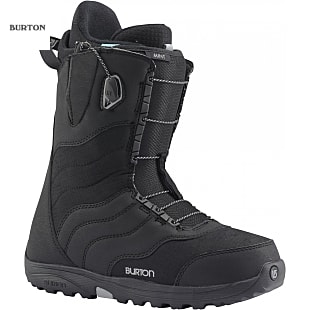- Sneakers & Skate Shoes
- Trail Running & Running Shoes
- Hiking & Approach Shoes
- Hiking & Trekking Boots
- Mountaineering Boots
- Ski Boots
- Snowboard Boots
- Climbing Shoes
- Cycling Shoes
- Winter Boots & Shoes
- Wellington Boots
- Sandals
- Tent Mules
- Footwear Accessories
- Watersport Shoes
- Approach Shoes
- Multifunctional Shoes
Snowboard Boots

By Popularity
Snowboard boots at eXXpozed
Softboots or Hardboots?
Snowboard boots are an essential piece of equipment for snowboarding. The boots are attached to the snowboard binding and thus form the link between foot and board. Ideally, snowboard boots should provide grip, be comfortable, warm and fit the rider's riding style and area of use. Basically, a distinction can be made between soft boots and hard boots. The hard boot consists of an inflexible shaft and hard plastic materials, which is why they strongly resemble a classic alpine ski boot in terms of construction and feel. This snowboard boot offers the rider a lot of support, but restricts mobility in the ankle. For this reason, hard boots are the best choice for racers, carvers and all-mountain riders who need maximum control and safety when turning and racing. The hard shaft allows edge pressure to be built up directly and therefore enables fast edging and cut turns. This snowboard boot is perfect for high speeds and low drift percentages. When carving, you can use the entire width of the slope. If you want more flexibility of the snowboard boot, soft boots are recommended. These boots are softer and more flexible and suitable for all those who have freestyle or freeride at heart. With them, nothing stands in the way of trick riding, jumping and sliding. Due to the higher freedom of movement, walking without a board is also more pleasant.

What does the flex number mean?
The flex indicates the degree of hardness of the snowboard boots. The higher the flex, the harder and more aggressive the boots are; the lower, the softer the snowboard boots are. You can choose between boots from soft to medium to stiff. Likewise, you can rate the flex on a scale of 1-10. We distinguish the following flex grades:
- Soft boots with flex 1-4: Here, the shins are relieved and the wearer has to expend less energy. The boots are comfortable to wear, which is especially appreciated by beginners. But also freestylers are happy about this soft boot, because jumps are better cushioned by soft boots and thus make the park stay much easier.
- Medium boots with flex 4-7: A majority of snowboarders resort to a medium flex, as it is neither too stiff nor too soft. An ideal compromise for all those who, in addition to the park, are also sometimes riding off-piste and descend the mountain at higher speeds. Especially advanced snowboarders appreciate the extra grip in the boot.
- Stiff boots with flex 7-10: Especially carvers and racers love this flex, because it stabilizes the ankle and allows direct power transmission. Freeriding in the backcountry is also more fun with stiffer boots, as the rider thus retains control of the board even in mixed terrain. The same applies to splitboard boots. Stiffer boots are used here to make your ascent easier.
Which snowboard boot is chosen, of course, depends on personal preferences as well as the respective skills of the snowboarder.
What lacing systems are there?
There are various lacing systems for opening and closing snowboard boots. To make the most of your time on the slopes, lacing your boots should not take too much time. We would like to introduce you to the most popular systems:
- Lace-up: With this system, snowboard boots can be tied just like normal lace-up shoes and give you that sneaker feeling on the mountain. It allows you to customize the whole boot or individual zones of the boot. You can determine in which areas you want to have more freedom of movement. At the top of the snowboard boot extra hooks are located to maintain the tension of the laces at all times. Lace lacing is relatively time consuming and requires strength to tie. A plus point is that broken laces can be replaced quite easily.
- Zone lacing: Here, individual zones are adjusted directly. In a 1-zone model, the entire snowboard boot is laced and fixed. The 2-zone system is divided into a foot zone and shin zone and the individual zones are tied separately. The lacing system can be replaced only with greater expenses.
- Quick lacing system: Is also often referred to as "fast lacing" and already hints at the advantages this lacing system could have. Depending on the design, the lacing is done via one or two pulleys with handle, which is why this system is unbeatably fast and easy to handle.
- BOA lacing: Originally, the BOA closure comes from wakeboarding. Today it is found on a wide variety of shoes - for hiking, trail running or boarding. A steel cable is clamped to the closure knob, which pulls the laces together. By turning the little wheel, the lacing can be conveniently adjusted. The foot sits tightly in the shoe, but still gets the comfort that the foot needs. This system can only be repaired at great expense.
- Buckle system: Found exclusively on snowboard hard boots to ensure maximum power transmission. The buckles cannot be adjusted exactly to the shape of the foot. The focus here is on pressure build-up.
General statements about the best lacing system cannot be made. Here again, you have to try it out individually to find the best solution for yourself. Try to think about possible areas of use and properties that are important to you in advance.

How should the snowboard boot fit?
As a rule, you have the same size for a soft or hard boot as for normal leisure shoes. Note, however, that the shoes of some brand manufacturers can be larger or smaller and therefore differ from the normal case. When trying on snowboard boots, please wear functional socks only. Normal leisure socks are thinner, wool socks are thicker - it doesn't matter, both socks would distort the fit. The snowboard boots fit perfectly when the big toe slightly touches the shoe tips at the front while the body posture is upright and the legs are stretched out. If you get into riding position, meaning knees slightly bent, this contact should no longer exist and your heel should arrive at the back. Your entire foot slides back a little. As soon as the heel has the opportunity to slide upwards, the snowboard boot is too big and can in the worst case lead to blisters and unpleasant chafing. If the snowboard boot presses, take it off immediately and do yourself a favor. Very important: take your time when trying them out. With snowboard boots that are too stiff and not flexible enough, the fun of snowboarding will be lost. So you need boots that fit comfortably and follow every movement during an action-packed day.
How should I lace the snowboard boot?
Very important: snowboard boots should not be tied too tightly and not too loosely. In the worst case scenario, the first can impair blood flow to the feet and lead to numbness. The latter variant puts more strain on muscles and ligaments, as they have to compensate for all the impacts that the boot does not hold. This can become quite exhausting in the long run. Therefore, you should consider your personal preferences when choosing the lacing system and select a system that you can easily operate and readjust. With a little practice, you will quickly find the right dosage.
Our favorite topics: Snowboard jackets | Snowboard socks | Snowboard backpacks | Burton snowboard boots | Avalanche safety | Snowboards & splitboards








 Amazon Pay helps you shop quickly, safely and securely. You can pay on our website without re-entering your payment and address details. All Amazon transactions are protected by Amazon's A-to-z Guarantee.
Amazon Pay helps you shop quickly, safely and securely. You can pay on our website without re-entering your payment and address details. All Amazon transactions are protected by Amazon's A-to-z Guarantee.